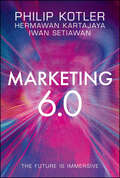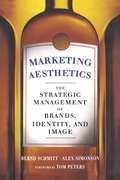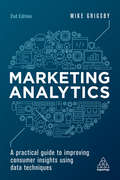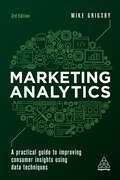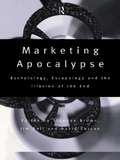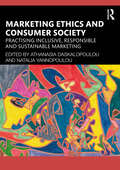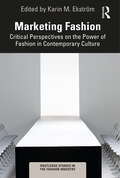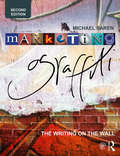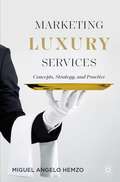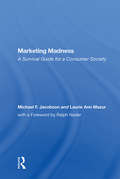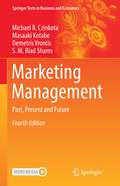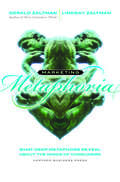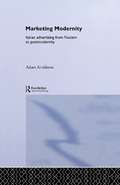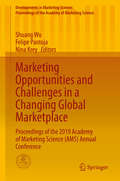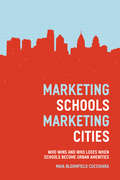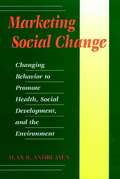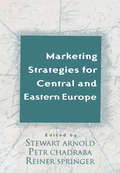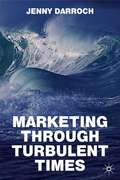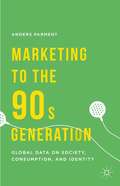- Table View
- List View
Marketing 6.0: The Future Is Immersive
by Philip Kotler Hermawan Kartajaya Iwan SetiawanRediscover the fundamentals of marketing along with the rise of metamarketing from the best in the business In Marketing 6.0, the celebrated promoter of the “Four P’s of Marketing,” Philip Kotler, explains how marketers can use technology to address customers’ needs and make a difference in the world. In a new age of metamarketing, this book provides marketers with a way to integrate technological and business model evolution with the dramatic shifts in consumer behavior that have happened in the last decade. Readers will learn about: The building blocks of metamarketing Generation Z and Generation Alpha and the technologies they use daily How to tap into metaverses and extended reality The potential obstacles and solutions for creating a more interactive and immersive experience. Marketing has evolved to address global challenges and changing customer expectations. Incorporating sustainability themes and new technologies for customer engagement are essential for businesses to remain relevant. Indeed, marketing has shifted from traditional to digital, but most customers still value some forms of human interaction. As a result, multichannel and omnichannel marketing have become popular among marketers aiming to leverage both traditional and digital engagement. Metamarketing goes beyond that and offers a genuine physical and digital convergence by providing a more interactive and immersive customer experience across physical and digital spaces.
Marketing Aesthetics: The Strategic Management of Brands, Identity, and Image
by Bernd H. Schmitt Alex SimonsonThere is no way to mistake the ubiquitous trademarked Coca-Cola bottle, or the stylish ads for Absolut Vodka with any of their competitors. How have these companies created this irresistible appeal for their brands? How have they sustained a competitive edge through aesthetics? Bernd Schmitt and Alex Simonson, two leading experts in the emerging field of identity management, offer clear guidelines for harnessing a company's total aesthetic output -- its "look and feel" -- to provide a vital competitive advantage. Going beyond standard traditional approaches on branding, this fascinating book is the first to combine branding, identity, and image and to show how aesthetics can be managed through logos, brochures, packages, and advertisements, as well as sounds, scents, and lighting, to sell "the memorable experience." The authors explore what makes a corporate or brand identity irresistible, what styles and themes are crucial for different contexts, and what meanings certain visual symbols convey. Any person in any organization in any industry can benefit from employing the tools of "marketing aesthetics." Schmitt and Simonson describe how a firm can use these tools strategically to create a variety of sensory experiences that will (1) ensure customer satisfaction and loyalty; (2) sustain lasting customer impressions about a brand's or organization's special personality; (3) permit premium pricing; (4) provide legal "trade dress" protection from competitive attacks; (5) lower costs and raise productivity; and (6) most importantly, create irresistible appeal. The authors show how to manage identity globally and how to develop aesthetically pleasing retail spaces and environments. They also address the newly emergent topic of how to manage corporate and brand identity on the Internet. Supporting their thesis with numerous real-world success stories such as Absolut Vodka, Nike, the Gap, Cathay Pacific Airlines, Starbucks, the New Beetle Website, and Lego, the authors explain how actual companies have developed, refined, and maintained distinct corporate identities that set them apart from competitors.
Marketing Analytics: A Practical Guide to Improving Consumer Insights Using Data Techniques (Marketing Science Ser.)
by Mike GrigsbyWho is most likely to buy and what is the best way to target them? How can businesses improve strategy without identifying the key influencing factors? The second edition of Marketing Analytics enables marketers and business analysts to leverage predictive techniques to measure and improve performance. By exploring real-world marketing challenges, it provides clear, jargon-free explanations on how to apply different analytical models for each purpose. From targeted list creation and data segmentation, to testing campaign effectiveness, pricing structures and forecasting demand, this book offers a welcome handbook on how statistics, consumer analytics and modelling can be put to optimal use. The fully revised second edition of Marketing Analytics includes three new chapters on big data analytics, insights and panel regression, including how to collect, separate and analyze big data. All of the advanced tools and techniques for predictive analytics have been updated, translating models such as tobit analysis for customer lifetime value into everyday use. Whether an experienced practitioner or having no prior knowledge, methodologies are simplified to ensure the more complex aspects of data and analytics are fully accessible for any level of application. Complete with downloadable data sets and test bank resources, this book supplies a concrete foundation to optimize marketing analytics for day-to-day business advantage.
Marketing Analytics: A Practical Guide to Improving Consumer Insights Using Data Techniques (Marketing Science Ser.)
by Mike GrigsbyWho is most likely to buy and what is the best way to target them? How can I use both consumer analytics and modelling to improve the impact of marketing campaigns? Marketing Analytics takes you step-by-step through these areas and more. Marketing Analytics enables you to leverage predictive techniques to measure and improve marketing performance. By exploring real-world marketing challenges, it provides clear, jargon-free explanations on how to apply different analytical models for each purpose. From targeted list creation and data segmentation, to testing campaign effectiveness, pricing structures and forecasting demand, it offers a complete resource for how statistics, consumer analytics and modelling can be put to optimal use. This revised and updated third edition of Marketing Analytics contains new material on forecasting, customer touchpoints modelling, and a new focus on customer loyalty. With accessible language throughout, methodologies are simplified to ensure the more complex aspects of data and analytics are fully accessible for any level of application. Supported by a glossary of key terms and supporting resources consisting of datasets, presentation slides for each chapter and a test bank of self-test question, this book supplies a concrete foundation for optimizing marketing analytics for day-to-day business advantage.
Marketing Analytics: Statistical Tools for Marketing and Consumer Behavior Using SPSS (Mastering Business Analytics)
by Erik Kostelijk José Marcos Carvalho de MesquitaMarketing Analytics provides guidelines in the application of statistics using IBM SPSS Statistics Software (SPSS) for students and professionals using quantitative methods in marketing and consumer behavior. With simple language and a practical, screenshot-led approach, the book presents 11 multivariate techniques and the steps required to perform analysis. Each chapter contains a brief description of the technique, followed by the possible marketing research applications. One of these applications is then used in detail to illustrate its applicability in a research context, including the needed SPSS commands and illustrations. Each chapter also includes practical exercises that require the readers to perform the technique and interpret the results, equipping students with the necessary skills to apply statistics by means of SPSS in marketing and consumer research. Finally, there is a list of articles employing the technique that can be used for further reading. This textbook provides introductory material for advanced undergraduate and postgraduate students studying marketing and consumer analytics, teaching methods along with practical software-applied training using SPSS. Support material includes two real data sets to illustrate the techniques’ applications and PowerPoint slides providing a step-by-step guide to the analysis and commented outcomes. Professionals are invited to use the book to select and use the appropriate analytics for their specific context.
Marketing Apocalypse: Eschatology, Escapology and the Illusion of the End (Routledge Interpretive Marketing Research)
by David Carson Stephen Brown Jim BellThe present volume of essays examines the extent to which the end of marketing is nigh. The authors explore the present state of marketing scholarship and put forward a variety of visions of marketing in the twenty first century. Ranging from narratology to feminism, these suggestions are always enlightening, often provocative and occasionally outrageous. Maketing Apocalypse is required reading for anyone interested in the future of marketing.
Marketing Ethics and Consumer Society: Practising Inclusive, Responsible and Sustainable Marketing
by Athanasia Daskalopoulou Natalia YannopoulouThis unique new text explores marketing ethics, the impact of marketing on consumers’ lives, and the wider social, cultural, and political context of marketing activities.Taking a critical approach to marketing practice, the book discusses the growing sense of responsibility within the marketing discipline and addresses issues at the interface between marketing and society. Importantly for Marketing students, it works to develop an understanding of the impacts that marketing can have on consumers’ lives and the potential that future marketers have to shape contemporary society. Chapters cover marketing and advertising ethics, critical consumption, gender and race, brand activism, sustainability and corporate social responsibility, and understanding and protecting the consumer. Case studies drawn from international contexts featuring real-life and recognisable organisations are included in every chapter to bring the theory to life, enabling students to explore the ethical dilemmas and criticisms faced by organisations and consumers in contemporary society. Chapter outlines, learning outcomes, summaries, and self-assessment questions cement learning, whilst discussion questions aim to provoke interesting conversation.A much-needed and relevant textbook that brings together all the key contemporary topics in marketing ethics, this should be core reading for advanced undergraduate and postgraduate students studying modules on marketing ethics, ethical marketing and sustainability, and marketing and society.Online support materials include lecture slides and a test bank.
Marketing Fashion: Critical Perspectives on the Power of Fashion in Contemporary Culture (Routledge Studies in the Fashion Industry)
by Karin M. EkströmFashion as a societal phenomenon has fascinated scholars in different disciplines such as history, sociology, anthropology, psychology, and marketing often from an interdisciplinary perspective. Fashion mirrors societal changes, cultural norms, and values over time. It can be interpreted as mundane everyday practices, constructions of identity and status as well as being associated with the art world. In this book, the focus lies on marketing and the role of marketers when fashion permeates society in deliberate and subtle ways. This edited collection critically reflects upon the power of fashion in contemporary society and the role marketing and marketers play in the process of defining, creating, and preserving fashion, but also in divesting fashion that is no longer up to date. It expands on existing knowledge to better understand the role marketers play as cultural agents in determining fashion and its markets. Contributors to the book are international, advanced scholars from a variety of disciplines such as anthropology, marketing, psychology and sociology, who challenge traditional ways of thinking about marketing. In a society where problems with overproduction and excessive consumption represent major challenges, the critical perspective of the role fashion plays in contemporary society and what influence marketing has for shaping fashion are not merely relevant, but necessary. This cutting-edge, interdisciplinary book will appeal to scholars across a broad range of fields including fashion marketing, fashion studies, and consumer culture research. It will also be valuable for students in advanced courses of study in a variety of disciplines besides marketing.
Marketing Graffiti: The Writing on the Wall
by Mike SarenRadical and unique in its approach and presentation, Marketing Graffiti turns the traditional marketing introduction on its head by helping students to understand the part they already play as ‘consumers’ in the marketing process.Most marketing textbooks tackle the subject as a business function – i.e. how to "do" marketing in companies and other organizations. Marketing Graffiti shows how marketing is not just a business function but a part of our culture, and one in which we are all active as part-time marketers.By rejecting managerially-driven structures in this way, Saren's approach makes marketing immediate and instantly recognizable as a process and a phenomenon in which we are already complicit. It helps readers to become aware of what they already know. Critically examining a wide range of products, businesses, technologies, information, services, ads, packaging and branding, Saren utilizes everyday images and phenomena to draw out the conceptual foundations of marketing from a social science and cultural studies perspective as something that we all experience in everyday life. This new edition of the first critical marketing textbook discusses the role new technologies (such as social media) play in marketing culture and how this can potentially place more power in the clicks of the consumer. It includes new, updated or expanded sections on market exclusion, the role of the consumer in innovation, space and place, pricing, consumer communities, collaborative consumption and social media marketing. Leading experts in these fields of research and marketing practice also contribute additional sections on these topics. This essential marketing guide is supported by a range of teaching support materials including the latest journal and online references, guides to further reading, teaching slides and test bank questions
Marketing Hope: Get-Rich-Quick Schemes in Siberia
by Leonie SchiffauerMultilevel marketing and pyramid schemes promote the idea that participants can easily become rich. These popular economies turn ordinary people into advocates of their interests and missionaries of the American Dream. Marketing Hope looks at how different types of get-rich-quick schemes manifest themselves in a Siberian town. By focusing on their social dynamics, Leonie Schiffauer provides insights into how capitalist logic is learned and negotiated, and how it affects local realities in a post-Soviet environment.
Marketing Luxury Services: Concepts, Strategy, and Practice
by Miguel Angelo HemzoThis textbook discusses luxury marketing management, considering the broader range of decisions related to the complexities of offering luxury as services. Placing a strong emphasis on strategy as well as positioning and the market, it focuses on the challenges in luxury related to the traditional 4 Ps (Products, Place, Promotion and Price), in addition applying the service-dominant logic to luxury management in relation to the other 4 Ps in marketing decisions (People, Process, Panorama, and Productivity).The text opens with an exploration the history and evolution of the concept and definition of luxury and the effect upon the practice of luxury marketing today, concluding with an overview of the contemporary luxury market, description of the main players, and relevant industry trends. It then discusses marketing strategies as applied to the luxury market, including market identification, brand communication, product positioning, pricing, flow of goods, foreign market entry, and more.With contributions from luxury marketing practitioners to offer practical knowledge as well as real world cases studies, this textbook will equip students with a comprehensive understanding of marketing in the luxury industry and the tools necessary to be successful in the management of luxury brands.
Marketing Madness: A Survival Guide For A Consumer Society (Critical Studies In Comm And In Cultural Industries Ser.)
by Michael JacobsonIn 1983, Reese's Pieces made their debut on the silver screen, gobbled up by that lovable alien ET, and sales of the candy shot up instantly by 66 percent. Reebok has sponsored the U.S. Olympic team-and the Russian team, as well! The British Boy Scouts sell space on their merit badges to advertisers. Michael Jacobson, founder of the Washington, D.C
Marketing Management: Past, Present and Future (Springer Texts in Business and Economics)
by Michael R. Czinkota Masaaki Kotabe Demetris Vrontis S. M. ShamsThis textbook provides students with comprehensive insights on the classical and contemporary marketing theories and their practical implications. A fourth, revised edition of Marketing Management, the text features new classical and contemporary cases, new interdisciplinary and cross-functional implications of business management theories, contemporary marketing management principles and. futuristic application of marketing management theories and concepts. The core and complex issues are presented in a simplified manner providing students with a stimulating learning experience that enables critical thinking, understanding and future application. Each chapter features a chapter summary, key terms, review and discussion questions and a practice quiz. Throughout the text there are also specific teaching features to provide students and instructors with an enhanced pedagogical experience. These features include: The Manager’s Corner: These sections provide real-world examples that instructors may highlight to exemplify theory or as mini-cases for discussion. Marketing in Action: These sections ask students to apply concepts and theories to actual business situations. Web Exercises: These mini sections provide students with real world issues and suggest websites for more information. In addition, the authors provide ancillary lecture notes and Solution/Instructors manual online to aid instructors in their teaching activities.
Marketing Metaphoria
by Lindsay H. Zaltman Gerald ZaltmanWhy do advertising campaigns and new products often fail? Why do consumers feel that companies don't understand their needs? Because marketers themselves don't think deeply about consumers' innermost thoughts and feelings. Marketing Metaphoria is a groundbreaking book that reveals how to overcome this "depth deficit" and find the universal drivers of human behavior so vital to a firm's success.Marketing Metaphoria reveals the powerful unconscious viewing lenses--called "deep metaphors"-- that shape what people think, hear, say, and do.Drawing on thousands of one-on-one interviews in more than thirty countries, Gerald Zaltman and Lindsay Zaltman describe how some of the world's most successful companies as well as small firms, not-for-profits, and social enterprises have successfully leveraged deep metaphors to solve a wide variety of marketing problems. Marketing Metaphoria should convince you that everything consumers think and do is influenced at unconscious levels--and it will give you access to those deeper levels of thinking.
Marketing Modernity: Italian Advertising from Fascism to Postmodernity (Routledge Studies In Markets And Consumption Ser.)
by Adam ArvidssonIn Marketing Modernity, Adam Arvidsson traces the development of Italy's postmodern consumer culture from the 1920s to the present day. In so doing, Arvidsson argues that the culture of consumption we see in Italy today has its direct roots in the social vision articulated by the advertising industry in the years following the First World War. He then goes on to discuss how that vision was further elaborated by advertising's interaction with subsequent big discourses in Twentieth Century Italy: fascism, post-war mass political parties and the counter-culture of the 1960s and 1970s. Based on a wide range of primary sources, this fascinating book takes an innovative historical approach to the study of consumption.
Marketing Nutrition: Soy, Functional Foods, Biotechnology, and Obesity
by Brian WansinkAlthough encouraging people to eat more nutritiously can promote better health, most efforts by companies, health professionals, and even parents are disappointingly ineffective. Brian Wansink's Marketing Nutrition focuses on why people eat the foods they do, and what can be done to improve their nutrition. Wansink argues that the true challenge in marketing nutrition lies in leveraging new tools of consumer psychology (which he specifically demonstrates) and by applying lessons from other products' failures and successes. The key problem with marketing nutrition remains, after all, marketing.
Marketing Opportunities and Challenges in a Changing Global Marketplace: Proceedings of the 2019 Academy of Marketing Science (AMS) Annual Conference (Developments in Marketing Science: Proceedings of the Academy of Marketing Science)
by Nina Krey Shuang Wu Felipe PantojaThis proceedings volume explores marketing opportunities and challenges that exist in the current, fast-changing landscape of the global marketplace. Current global issues such as the rising middle class in emerging markets, disruptive technological breakthroughs, big data analytics, changing consumer habits and concerns over national trade policies have renewed ethical concerns around consumer privacy and the tools companies use to operate, market to, connect and build a relationship with their customers. Featuring the full proceedings from the 2019 Academy of Marketing Science (AMS) Annual Conference held in Vancouver, Canada, this book explores and assess the rate of change that drives companies to evaluate and adapt their marketing strategies to remain competitive.Founded in 1971, the Academy of Marketing Science is an international organization dedicated to promoting timely explorations of phenomena related to the science of marketing in theory, research, and practice. Among its services to members and the community at large, the Academy offers conferences, congresses, and symposia that attract delegates from around the world. Presentations from these events are published in this Proceedings series, which offers a comprehensive archive of volumes reflecting the evolution of the field. Volumes deliver cutting-edge research and insights, complementing the Academy’s flagship journals, the Journal of the Academy of Marketing Science (JAMS) and AMS Review (AMSR). Volumes are edited by leading scholars and practitioners across a wide range of subject areas in marketing science.
Marketing Schools, Marketing Cities: Who Wins and Who Loses When Schools Become Urban Amenities
by Maia Bloomfield CucchiaraDiscuss real estate with any young family and the subject of schools is certain to come up—in fact, it will likely be a crucial factor in determining where that family lives. Not merely institutions of learning, schools have increasingly become a sign of a neighborhood’s vitality, and city planners have ever more explicitly promoted “good schools” as a means of attracting more affluent families to urban areas, a dynamic process that Maia Bloomfield Cucchiara critically examines in Marketing Schools, Marketing Cities. Focusing on Philadelphia’s Center City Schools Initiative, she shows how education policy makes overt attempts to prevent, or at least slow, middle-class flight to the suburbs. Navigating complex ethical terrain, she balances the successes of such policies in strengthening urban schools and communities against the inherent social injustices they propagate—the further marginalization and disempowerment of lowerclass families. By asking what happens when affluent parents become “valued customers,” Marketing Schools, Marketing Cities uncovers a problematic relationship between public institutions and private markets, where the former are used to leverage the latter to effect urban transformations.
Marketing Science Fictions: An Ethnography of Marketing Analytics, Consumer Insight, and Data Science
by Robert CluleyThis book explores data science in practice through an ethnographic study at a global marketing technology and research firm. The book shows that, while businesses have embraced data science methods to understand markets and consumers, in practice they produce too much information. Consequently, they must be combined with creative practices that simplify and make sense of analytics. Cluley shows that in the age of data science, business is increasingly artistic. In this case, marketing science is more like marketing science fiction. This is essential reading for understanding contemporary data-driven business and marketing as well as social and economic relations in the age of surveillance capitalism, with lessons for academics and students of marketing, technology and data science.
Marketing Scientific And Technical Information
by William R. King Gerald ZaltmanCreating and disseminating scientific and technical information (STI) can be likened to producing and distributing a product or service. Although this view is natural to marketing scholars and practitioners, it is not one that has been extensively applied to STI policymaking and research. This book assesses and demonstrates the applicability and potential of various areas of marketing theory in the STI context. It includes the work of distinguished marketing scholars who have analyzed STI marketing from such perspectives as consumer needs assessment, information acquisition strategy, market segmentation, and product design.
Marketing Social Change. Changing Behavior to Promote Health, Social Development, and the Environment
by Alan R. AndreasenApplies marketing techniques to social issues.
Marketing Strategies for Central and Eastern Europe
by Stewart Arnold Petr Chadraba Reiner SpringerThis title was first published in 2001. Successful international marketing requires the development and implementation of marketing strategies responsive to different environments. This text examines the unique features of the marketing environment in Central and Eastern Europe and the impact that they have on the strategies used to enter and penetrate this region. It is based on the proceedings of the 6th annual conference on "Marketing Strategies for Central & Eastern Europe" held from the 2nd to the 4th of December 1998 in Vienna, Austria. The book presents the editors' view on marketing in Central and Eastern Europe and summarizes the main features and research results from the selected papers.
Marketing Technologies: Corporate Cultures and Technological Change (Routledge Studies in Innovation, Organizations and Technology)
by Elena SimakovaGlobal corporations initiate, join and maintain socio-technological change and hence, alter the ways in which we organize our lives. Demanding significant investment of resources and time, the development and implementation of new technologies on different levels must take into consideration these subtle processes. As such, it is particularly important that we have a greater insight into the practices of hi-tech corporations, in view of the often inflated promises of and concerns about the destiny of technological breakthroughs, especially those promising sizeable economic outcomes and societal transformation. Elena Simakova undertook a lengthy ethnographic study, working alongside marketing managers in a global IT corporation in their Europe, Middle East and Africa (EMEA) headquarters in the UK. Using the experience gained through a close participation in their everyday corporate rituals and routines, her account challenges common perceptions of how corporations make the world think and act with regard to technologies in particular ways. The book contains an interesting case study on the launch of a radio frequency identification (RFID) based solution. Unravelling the construction of expectations, inclusions and exclusions around emerging technologies, this reflexive account also tackles uneasy practical and methodological questions pertinent to corporate ethnography. This book is an essential read for scholars in science and technology studies, economic sociology, anthropology, as well as management and organizational studies and research policy.
Marketing Through Turbulent Times
by Jenny DarrochAt some time in the future the recession will end. But what will happen then? How will customers respond to organizations that mistreated them in the past? What can organizations do now? Marketing Through Turbulent Times addresses these questions by tying together four themes: democracy, economic recession, individual depression and customer-centred strategies. Written for decision makers who want to ensure that their marketing strategies are not only relevant for today’s difficult environment but will also provide a solid foundation for future growth, this book is an invaluable resource for anyone making strategic marketing decisions. Marketing Through Turbulent Times is a common sense, accessible book about marketing that provides a range of tools, principles and approaches for managers wanting to fine tune their current marketing strategies today and identify innovative growth opportunities which will allow them to lead their organization toward a robust future. http://www. marketingthroughturbulenttimes. com/ *A Note From the Author, Jenny Darroch: This book has dealt with one of the BIG problems facing managers today: 'How do I manage effectively in such turbulent times?' The recession will end. Does this mean that the contents of this book are no longer relevant? No. Even in periods of growth, creating turbulence, staying relevant, maintaining momentum, executing current strategies well, and forcing changes to product-market boundaries will remain essential ingredients for any organization wanting to grow, reconfigure, and survive. And so, while the growth strategies I have outlined in Marketing through Turbulent Times are relevant today, they will endure and provide guidance for managers wanting to create turbulence when the recession passes. The strategies outlined in this book are appropriate for any organization where generating growth is a primary goal. All that will change over time is what constitutes relevance Sincerely, Jenny Darroch
Marketing To The 90s Generation
by Anders ParmentMarketing to the 90s Generation is based on original research conducted by sociologists and psychologists on generational cohorts. This book explores how they come about, what defines them, and what they mean to society, institutions, and companies. Parment analyses hundreds of interviews with individuals from across the world, several focus groups, and a survey study with 4,707 complete answers from summer 2013 (Germany, China, the U. S. and Sweden) to create a comprehensive analysis of what makes the generation of individuals born in the 1990s unique. This exciting new book is enlightening to employers, marketers, politicians, policy-makers, and other decision-makers looking to appeal to members of the 90s generation.
